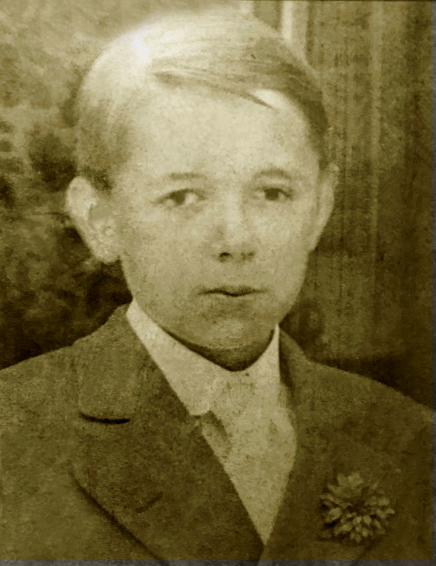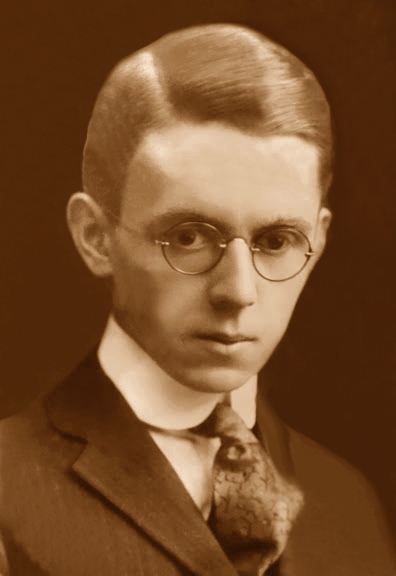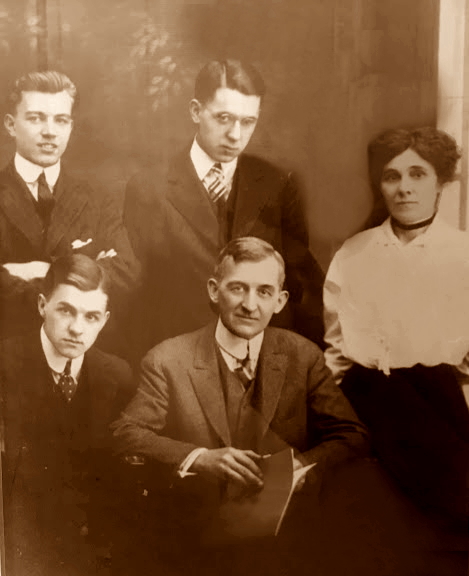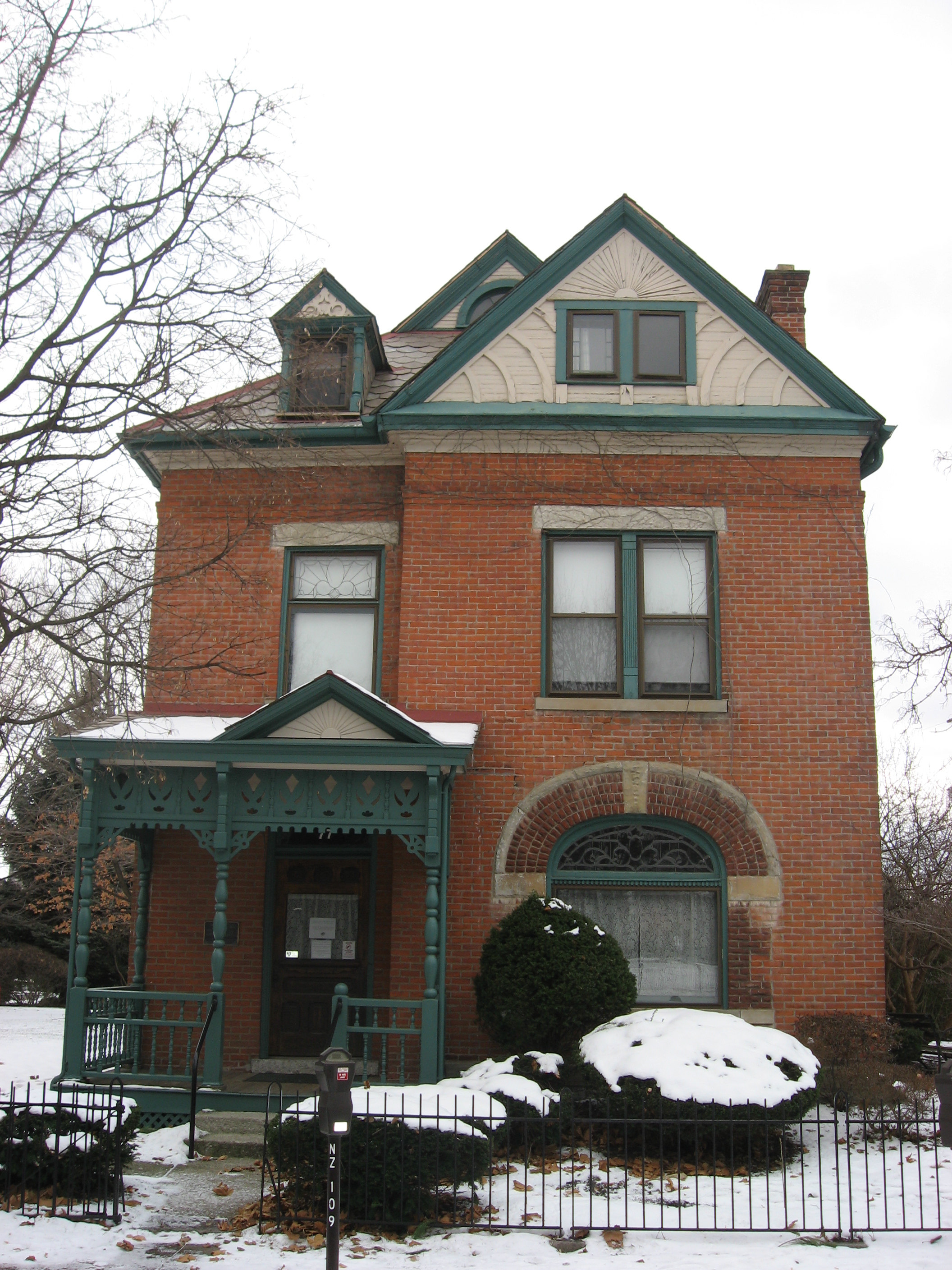1. Life
James Thurber's life was marked by significant personal milestones and challenges, from his formative years in Ohio to his influential career in New York, all of which profoundly shaped his distinctive literary and artistic output.
1.1. Early Life and Family Background
James Grover Thurber was born in Columbus, Ohio, on December 8, 1894. His parents, Charles L. Thurber and Mary Agnes "Mame" (née Fisher) Thurber, played a substantial role in influencing his creative work. His father was a sporadically employed clerk and a minor politician who harbored aspirations of becoming a lawyer or an actor. Thurber often described his mother as a "born comedian" and regarded her as "one of the finest comic talents" he had ever encountered. She was known for her practical jokes, including one instance where she feigned a disability to attend a faith healing revival, only to dramatically jump up and declare herself cured. Due to overcrowding in his grandfather's house, where his family had temporarily moved while his father was recovering from an illness, Thurber frequently stayed at the home of his aunt, Margery Albright. Albright lived in Downtown Columbus near Holy Cross Church, whose clock and bell later became recurring references in Thurber's writings.
1.2. Childhood and Vision Loss
At the age of seven, Thurber suffered a severe eye injury while playing a game of William Tell with one of his brothers, who accidentally shot him in the eye with an arrow. This incident resulted in the loss of his left eye and, over time, led to him becoming almost entirely blind. This injury significantly limited his participation in sports and other childhood activities, but it also fostered the development of a profound creative mind, which he channeled into his writing and drawing. Neurologist V. S. Ramachandran has suggested that Thurber's vivid imagination might be partly explained by Charles Bonnet syndrome, a neurological condition characterized by complex visual hallucinations in individuals experiencing some degree of visual loss. This condition is said to have inspired his piece "The Admiral on the Wheel".


1.3. Education and Early Career
From 1913 to 1918, Thurber attended Ohio State University, where he was an active member of the Phi Kappa Psi fraternity and served as editor of the student magazine, the Sundial. During this period, he rented the house at 77 Jefferson Avenue in Columbus, which would later be designated as Thurber House in 1984. He was unable to graduate from the university because his deteriorating eyesight prevented him from completing a mandatory Reserve Officers' Training Corps (ROTC) course. However, he was posthumously awarded a degree from the university in 1995.
From 1918 to 1920, Thurber worked as a code clerk for the United States Department of State, initially in Washington, D.C., and later at the U.S. embassy in Paris. Upon his return to Columbus, he embarked on a career as a reporter for The Columbus Dispatch from 1921 to 1924. During this time, he contributed a weekly column titled "Credos and Curios," in which he reviewed books, films, and plays. This title was later used for a posthumous collection of his work. Thurber also returned to Paris during this period, where he wrote for the Chicago Tribune and other newspapers.


1.4. Move to New York and The New Yorker
In 1925, Thurber relocated to Greenwich Village in New York City, securing a position as a reporter with the New York Evening Post. In 1927, he joined the staff of The New Yorker as an editor, a move facilitated by his friend and fellow New Yorker contributor, E. B. White. Thurber's career as a cartoonist began serendipitously in 1930 after White discovered some of Thurber's drawings in a trash can and submitted them for publication. White initially inked some of these early drawings to improve their reproduction quality for the magazine, a decision he later expressed deep regret over. Thurber continued to contribute both his writings and his distinctive drawings to The New Yorker until the 1950s, becoming one of the magazine's most iconic figures.
1.5. Marriage and Personal Life
Thurber married Althea Adams in 1922. However, this marriage, as he later confided to a friend, evolved into a "charming, fine, and hurting" relationship. They resided in the Sanford-Curtis-Thurber House in Fairfield County, Connecticut, and had one daughter, Rosemary, born in 1931. The marriage concluded in divorce in May 1935, with Althea retaining ownership of the Sanford-Curtis-Thurber House. In June 1935, Thurber married his editor, Helen Muriel Wismer (1902-1986). After an encounter with Mark Van Doren on a ferry to Martha's Vineyard, Thurber began spending his summers in Cornwall, Connecticut, a popular retreat for many prominent artists and authors of the time. After three years of renting, Thurber found a permanent home in Cornwall, which he affectionately referred to as "The Great Good Place."
1.6. Death
In his final year, Thurber's behavior became increasingly erratic. On October 4, 1961, he suffered a blood clot on the brain and underwent emergency surgery. Although the operation was initially deemed successful, Thurber drifted in and out of consciousness. He ultimately died a few weeks later, on November 2, 1961, at the age of 66, due to complications from pneumonia. Doctors reported that his brain showed signs of senescence (aging), attributed to several small strokes and hardening of the arteries. According to his wife, Helen, Thurber's last words, apart from repeatedly uttering "God," were "God bless... God damn."
2. Career
James Thurber's career spanned a remarkable range of creative endeavors, establishing him as a prominent figure in American literature and art through his distinctive humor, insightful social commentary, and unique artistic style.
2.1. Writer
Thurber's literary output was extensive, encompassing short stories, essays, fables, and children's literature, all characterized by his unique blend of humor, social commentary, and observations on human nature. His final two decades were marked by significant material and professional success despite his progressive blindness, during which he published at least fourteen books.
2.1.1. Short Stories and Essays
Many of Thurber's short stories are humorous, fictionalized memoirs drawn from his own life experiences. However, he also explored darker themes, as evidenced in "The Whip-Poor-Will," a story delving into madness and murder. Among his most celebrated short stories are "The Dog That Bit People" and "The Night the Bed Fell," both of which are featured in My Life and Hard Times, a book considered his breakthrough work. Other classic stories include "The Secret Life of Walter Mitty", "The Catbird Seat", "The Night the Ghost Got In", "A Couple of Hamburgers", "The Greatest Man in the World", and "If Grant Had Been Drinking at Appomattox". His collection The Middle-Aged Man on the Flying Trapeze contains several short stories that subtly explore underlying marital discord, a theme perhaps influenced by its publication during the year of his divorce and remarriage.
His 1941 story "You Could Look It Up," which features a three-foot adult being brought in to take a walk in a baseball game, has been cited as an inspiration for Bill Veeck's famous stunt with Eddie Gaedel for the St. Louis Browns in 1951, though Veeck himself claimed an older provenance for the idea. Thurber also wrote a five-part series for The New Yorker between 1947 and 1948, offering an in-depth examination of the radio soap opera phenomenon. Based on extensive listening and research, this series, later republished as "Soapland" in his anthology The Beast in Me and Other Animals (1948), was one of the earliest comprehensive studies of a pop-culture phenomenon. Notable books from this successful period include The Thurber Carnival (1945), Thurber Country (1953), and the highly popular biographical work about New Yorker founder and editor Harold Ross, titled The Years with Ross (1959).
2.1.2. Fables and Children's Literature
In addition to his other fiction, Thurber authored more than seventy-five fables. Some were initially published in The New Yorker in 1939 and subsequently collected in Fables for Our Time and Famous Poems Illustrated (1940) and Further Fables for Our Time (1956). These short narratives typically featured anthropomorphic animals as main characters and concluded with a moral tagline. A notable exception to this format is his most famous fable, "The Unicorn in the Garden," which features an entirely human cast, save for the non-speaking unicorn. Thurber's fables were inherently satirical, with their morals serving as both punch lines and pieces of advice to the reader, illustrating "the complexity of life by depicting the world as an uncertain, precarious place, where few reliable guidelines exist."
His contributions to children's literature include several book-length fairy tales, such as The White Deer (1945), The 13 Clocks (1950), and The Wonderful O (1957). The latter two, along with several other works by Thurber, were notably illustrated by Marc Simont. Notably, Albert Camus translated "The Last Flower" into French.
2.1.3. Prose and Language
Thurber's prose for The New Yorker and other publications included numerous humorous essays. A particular subject of interest, especially in his later life, was the English language. His pieces on this topic included "The Spreading 'You Know'," which criticized the overuse of that phrase in conversation, "The New Vocabularianism," and "What Do You Mean It Was Brillig?". Thurber and the staff of The New Yorker often referred to his short pieces-whether stories, essays, or a blend of both-as "casuals."
2.2. Cartoonist
James Thurber also gained considerable renown for his simple, often outlandish, and surreal drawings and cartoons. His artistic talents, much like his literary skills, were significantly fostered by the support and collaboration of his fellow New Yorker staff member, E. B. White, who championed the idea that Thurber's sketches could stand independently as artistic expressions. Thurber created six covers and numerous classic illustrations for The New Yorker.
While Thurber initially drew his cartoons in the conventional manner during the 1920s and 1930s, his progressively failing eyesight necessitated changes in his technique. He adapted by drawing on very large sheets of paper using a thick black crayon, or sometimes on black paper with white chalk, which were then photographed and color-reversed for publication. Regardless of the method, his cartoons became as celebrated as his writings, distinguished by an eerie, wobbly quality that seemed to mirror his idiosyncratic view of life. He once remarked that people commented his drawings looked as if they were created underwater. Dorothy Parker, a contemporary and friend of Thurber's, famously described his cartoons as having the "semblance of unbaked cookies." Thurber's final completed drawing was a self-portrait rendered in yellow crayon on black paper, which notably graced the cover of Time magazine on July 9, 1951. The same drawing was also used for the dust jacket of The Thurber Album (1952). Thurber was also known as an avid dog lover, and many of his cartoons and literary works featured dogs as central themes or characters.
2.3. Plays and Adaptations
Thurber's creative works have seen numerous adaptations across various media, including successful plays, films, and television series, demonstrating their enduring appeal.
Thurber collaborated with his college friend, actor and director Elliott Nugent, to write The Male Animal, a comic drama that became a significant Broadway hit in 1939. The play was subsequently adapted into a film of the same name in 1942, starring Henry Fonda, Olivia de Havilland, and Jack Carson.
His iconic short story "The Secret Life of Walter Mitty" has been loosely adapted into films twice: in 1947, starring Danny Kaye in the title role (released in Japan as 虹を掴む男Niji o Tsukamu OtokoJapanese), and again in 2013, with Ben Stiller portraying the main character (released in Japan as LIFE!).
In 1951, United Productions of America (UPA) announced an ambitious animated feature film based on Thurber's work, titled Men, Women and Dogs. However, the only segment of this project that was ultimately released was the UPA cartoon The Unicorn in the Garden in 1953.
In 1958, Thurber's short story "One Is a Wanderer" was adapted for General Electric Theatre, earning Emmy nominations for writer Samuel A. Taylor and director Herschel Daugherty. The 1959 film The Battle of the Sexes was also based on Thurber's 1942 short story "The Catbird Seat".
In 1960, Thurber fulfilled a long-held desire to perform on a professional stage, playing himself in 88 performances of the revue A Thurber Carnival. This production, which echoed the title of his 1945 book, The Thurber Carnival, was based on a selection of his stories and cartoon captions. Thurber appeared in the sketch "File and Forget," which depicted him dictating a series of letters in a futile attempt to prevent a publisher from sending him unordered books, leading to escalating confusion. For his contribution to the adapted script of the Carnival, Thurber received a Special Tony Award.
In 1961, "The Secret Life of James Thurber" aired on The DuPont Show with June Allyson, featuring Adolphe Menjou as Fitch, and Orson Bean and Sue Randall as John and Ellen Monroe. From 1969 to 1970, a full television series titled My World-and Welcome to It (known in Japan as パパはメロメロ!Papa wa Meromero!Japanese), based on Thurber's writings and life, was broadcast on NBC. The show starred William Windom as the Thurber-like character, John Monroe, and incorporated animated segments alongside live actors. This series won a 1970 Emmy Award for Best Comedy Series, and Windom also received an Emmy for his performance. He later continued to perform Thurber material in a one-man stage show. In 1972, another film adaptation, The War Between Men and Women, starring Jack Lemmon, concluded with an animated version of Thurber's classic anti-war work "The Last Flower."
3. In Popular Culture
James Thurber's distinctive humor and unique perspective have left a lasting cultural footprint, influencing and being referenced across various forms of popular media.
In Season Nine, Episode 13 of Seinfeld, titled "The Cartoon", Elaine Benes mentions learning gossip about Thurber during a job interview at The New Yorker. Television broadcaster Keith Olbermann frequently read excerpts from Thurber's short stories during the closing segment of his MSNBC program Countdown with Keith Olbermann on Fridays, a segment he affectionately named "Fridays with Thurber." He revived this practice during the COVID-19 pandemic in 2020, reading Thurber stories daily on Twitter, and continued it on his podcast, also titled Countdown with Keith Olbermann. On an episode of Norm Macdonald's video podcast, Norm Macdonald Live, comedian Larry Miller acknowledged Thurber as his biggest comedic influence. In the 2021 film The French Dispatch by director Wes Anderson, James Thurber was explicitly mentioned in the end credits as an inspiration for the film's unique style and narrative.
4. Legacy and Honors
James Thurber's work continues to be recognized for its profound impact on American humor and literature, with several honors and institutions dedicated to preserving his legacy.
4.1. Thurber Prize for American Humor
Established in 1997, the annual Thurber Prize is a prestigious literary award that honors outstanding examples of American humor. This award reflects Thurber's significant and lasting influence on the genre of humor writing.
4.2. Historic Residences
Two of James Thurber's former residences have been designated as historically significant and listed on the U.S. National Register of Historic Places. These include his childhood home, the Thurber House in Ohio, and the Sanford-Curtis-Thurber House in Fairfield County, Connecticut, where he lived during his first marriage. These designations acknowledge their historical importance and connection to the celebrated author.
4.3. Influence
Thurber's unique blend of wit, satire, and poignant observations on the human condition has exerted a broad influence on subsequent generations of writers, artists, and the broader cultural landscape. His distinctive style, characterized by its understated humor, surreal elements, and insightful commentary on the absurdities of modern life, particularly in the realm of humor, satire, and observational writing, has inspired countless creative individuals. In 2008, the Library of America selected Thurber's story, "A Sort of Genius," first published in The New Yorker, for inclusion in its two-century retrospective of American True Crime.
5. Bibliography
James Thurber's extensive bibliography includes numerous books, children's stories, plays, and posthumously published collections, showcasing his prolific career as a writer and humorist.
5.1. Books
- Is Sex Necessary? Or, Why You Feel the Way You Do (1929, with E. B. White)
- The Owl in the Attic and Other Perplexities (1931)
- The Seal in the Bedroom and Other Predicaments (1932)
- My Life and Hard Times (1933)
- The Middle-Aged Man on the Flying Trapeze (1935)
- Let Your Mind Alone! and Other More or Less Inspirational Pieces (1937)
- The Last Flower (1939)
- Fables for Our Time and Famous Poems Illustrated (1940)
- My World-And Welcome to It (1942)
- Men, Women and Dogs (1943)
- The Thurber Carnival (anthology, 1945)
- The Beast in Me and Other Animals (1948)
- The Thurber Album (1952)
- Thurber Country (1953)
- Thurber's Dogs (1955)
- Further Fables for Our Time (1956)
- Alarms and Diversions (anthology, 1957)
- The Years with Ross (1959)
- Lanterns and Lances (1961)
5.2. Children's Books
- Many Moons (1943)
- The Great Quillow (1944)
- The White Deer (1945)
- The 13 Clocks (1950)
- The Wonderful O (1957)
5.3. Plays
- The Male Animal (1940, with Elliott Nugent)
- A Thurber Carnival (1960)
5.4. Posthumous Publications
- Credos and Curios (1962, edited by Helen W. Thurber)
- Thurber & Company (1966, edited by Helen W. Thurber)
- Selected Letters of James Thurber (1981, edited by Helen W. Thurber & Edward Weeks)
- Collecting Himself: James Thurber on Writing and Writers, Humor and Himself (1989, edited by Michael J. Rosen)
- Thurber on Crime (1991, edited by Robert Lopresti)
- People Have More Fun Than Anybody: A Centennial Celebration of Drawings and Writings by James Thurber (1994, edited by Michael J. Rosen)
- James Thurber: Writings and Drawings (anthology, 1996, edited by Garrison Keillor, Library of America)
- The Dog Department: James Thurber on Hounds, Scotties, and Talking Poodles (2001, edited by Michael J. Rosen)
- The Thurber Letters: The Wit, Wisdom, and Surprising Life of James Thurber (2002, edited by Harrison Kinney, with Rosemary A. Thurber)
- Collected Fables (2019, edited by Michael J. Rosen)
- A Mile and a Half of Lines: The Art of James Thurber (2019, edited by Michael J. Rosen)
5.5. Short Stories
- "A Box to Hide In"
- "The Admiral on the Wheel"
- "A Couple of Hamburgers"
- "A Ride with Olympy"
- "A Sequence of Servants"
- "The Bear Who Let it Alone"
- "The Black Magic of Barney Haller"
- "The Breaking Up of the Winships" (1945)
- "The Cane in the Corridor"
- "The Car We Had to Push"
- "The Catbird Seat" (1942)
- "The Crow and the Oriole"
- "The Curb in the Sky" (1931)
- "The Day the Dam Broke"
- "The Departure of Emma Inch"
- "Destructive Forces Life"
- "Doc Marlowe"
- "Draft Board Nights"
- "File and Forget" (1949)
- "The Figgerin' Of Aunt Wilma" (1950)
- "A Friend to Alexander"
- "The Glass in the Field"
- "The Greatest Man in the World"
- "If Grant had been Drinking at Appomattox"
- "The Lady on 142"
- "The Little Girl and the Wolf"
- "The Macbeth Murder Mystery" (1937)
- "The Man Who Hated Moonbaum"
- "More Alarms at Night"
- "The Moth and the Star"
- "Mr. Preble Gets Rid of His Wife"
- "The Night the Bed Fell"
- "The Night the Ghost Got In"
- "Oh When I Was..."
- "One is a Wanderer"
- "The Owl Who Was God"
- "The Peacelike Mongoose"
- "The Princess and the Tin Box"
- "The Rabbits Who Caused All the Trouble"
- "The Remarkable Case of Mr.Bruhl"
- "The Scotty Who Knew Too Much"
- "The Seal Who Became Famous"
- "The Secret Life of James Thurber" (1943)
- "The Secret Life of Walter Mitty"
- "Sex Ex Machina"
- "The Sheep in Wolf's Clothing" (1939)
- "Snapshot of a Dog"
- "The Subjunctive Mood" (1929)
- "The Tiger Who Was to Be King"
- "The Topaz Cuff Links Mystery"
- "The Dog That Bit People"
- "The Evening's at Seven"
- "The Unicorn in the Garden"
- "University Days"
- "What Do You Mean It Was Brillig?"
- "The Whip-Poor-Will"
- "The Wood Duck"
- "You Could Look It Up" (1941)